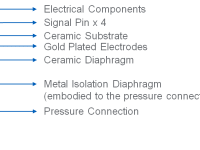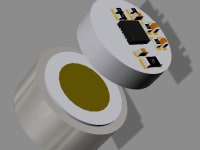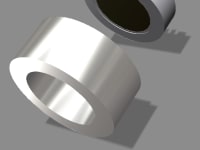Wheatstone bridge and capacitance are among the most popular pressure sensing principals used in pressure sensors. Wheatstone bridge comprises resistor network formed as thin film strain gauge on metal diaphragm or as piezo resistive element on silicon diaphragm, while capacitive pressure sensor element comprises two electrodes formed on ceramic diaphragm and substrate or on silicon diaphragm and substrate.
Silicon is a perfect elastic material, that is why silicon is the best material for pressure sensing element diaphragm. Silicon diaphragm will deflect if pressure is applied, and will return to its original position if pressure is removed. However, silicon is not compatible with all type of pressure media. Silicon is only compatible with N2 gas or dry air. To be able to measure other pressure media, metal isolation diaphragm must be used and silicone oil is required to transfer pressure, so called oil-filled construction. There is drawback in this construction, as metal isolation must be made as thin as possible, usually between 20um to 25um. It makes oil-filled pressure sensor is not suitable for hydrogen gas application, as hydrogen will permeate through isolation diaphragm. Once hydrogen gas gets into silicone oil, pressure sensor performance will deteriorate.
Ceramic is also perfect elastic material. Unlike silicon, ceramic material is more robust in harsh environment. However, ceramic diaphragm must be sealed to metal body by either rubber o-ring or adhesive. Again, in hydrogen atmosphere, rubber o-ring or adhesive can be harmed.
Strain gauge on metal diaphragm may be good in terms of hydrogen gas compatibility, because of thicker metal diaphragm construction. However, in opposite stability must be sacrificed, thus accuracy is not as good as both technologies mentioned above.
To achieve both hydrogen gas compatibility and stability, we will combine the advantage of thick metal diaphragm and ceramic diaphragm. We will call it hybrid diaphragm. The idea is to utilize thick metal isolation diaphragm to keep hydrogen gas compatibility, but it will not be used to measure deflection. We will use ceramic property to sense deflection. There will be no silicone oil used, so pressure applied to metal diaphragm will be transferred directly to the ceramic diaphragm. We will introduce a method which is already well-established to form thick ceramic layer on top of metal isolation diaphragm. This ceramic layer will perform as ceramic diaphragm, and it will be dominant compare to metal isolation diaphragm, thus stability can still be maintained to keep good accuracy.
The most preferred method is so-called aerosol deposition. With this method, ceramic powder is sprayed to a target at room temperature to form thick ceramic layer. In this case, metal isolation diaphragm will be the target. This thick ceramic layer will become ceramic diaphragm which is used measure deflection. On top of the ceramic diaphragm, gold plating is deposited to form electrode. Substrate is made of sintered ceramic powder and gold plating is also deposited to substrate to form electrode. At the end, this substrate will be bonded to ceramic diaphragm to build capacitive sensing element.
Like this entry?
-
About the Entrant
- Name:Edwin Sidik
- Type of entry:individual
- Software used for this entry:Autodesk Inventor
- Patent status:none








